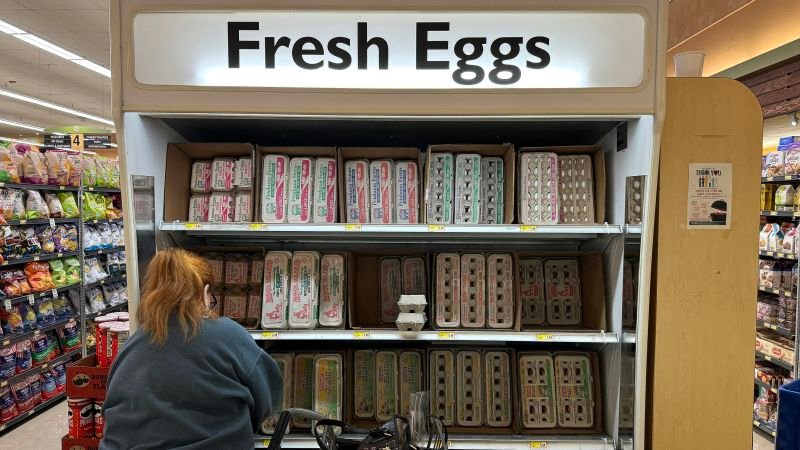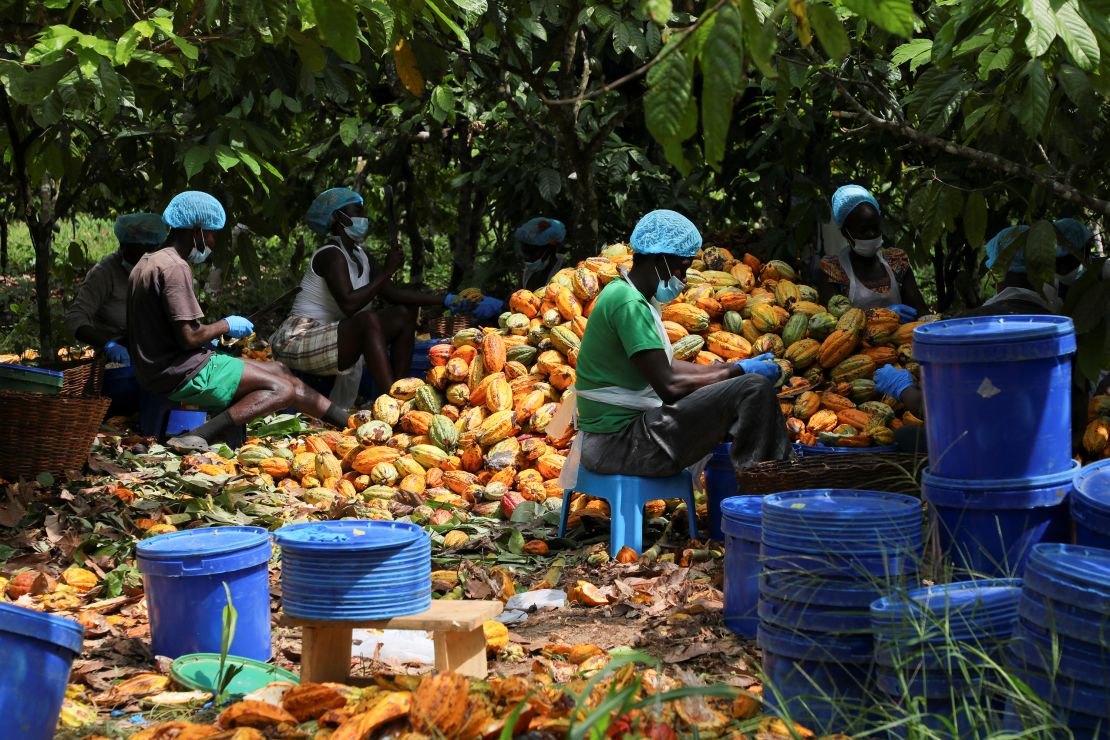Physical Address
304 North Cardinal St.
Dorchester Center, MA 02124
Physical Address
304 North Cardinal St.
Dorchester Center, MA 02124

Rochester, Minnesota
CNN
—
The Sunday before Thanksgiving, a grocery store here was empty of eggs.
An hour and a half north in Richfield, some eggs could be had, but they weren’t cheap. That dozen cost $1.70 more – a good 40% higher – than four months ago.
in november egg prices increased by 8.2% nationwide, registering one of the largest monthly increases in two decades, according to Consumer Price Index data released last week. And it’s not just eggs: shoppers saw jumps in beef, coffee and soft drinks, leading to overall grocery prices posting their biggest monthly gain since January 2023.
And it looks like more ups and downs are coming for the tissue-wrapped protein: Wholesale prices chicken eggs rose nearly 55% last month, and wholesale food prices rose 3.1% (the largest monthly increase in two years).
Economists say not to panic. The “egg inflation” and sudden price increases in some major food categories are a reflection of isolated events rather than something systemic and indicative of accelerating inflation.
However, that doesn’t make it any easier for Americans, whose prices have been rising much faster than usual for years.
But even if they are superficial, these price increases add another layer of cost to products that were significantly more expensive before the pandemic.
“Food price inflation is generally quite tame; it’s basically in line with where it was before the pandemic…nothing to worry about,” said Gregory Daco, chief economist at EY Parthenon. “But prices remain very high relative to where they were before the pandemic.”
The generation-long struggle with high inflation — though it resulted from a confluence of factors stemming from the pandemic, the war in Ukraine and other events — weighed heavily on Americans and ultimately driven Former President Donald Trump returned to the White House.
Even before “inflation” became a household word, food prices have long been subject to fluctuations weather events, crop yields, diseases, the warsupply chain lulls, surges in demand or other temporary disruptions.
And that’s what happens here with eggs (and beef and coffee and orange juice).
“Inflation is what it is, but we’re seeing a more pronounced increase in pockets of the food aisle, not necessarily across the board,” said Billy Roberts, senior food and beverage analyst at CoBank, a cooperative bank serving agribusinesses.
Eggs (+37.5% per year): An outbreak of bird flu ravages flocks across the country, reducing supply at the same time when Americans are in a festive mood and baking, cooking and dining.
USDA in December further revised US egg supply estimates and raised price forecasts for 2025.
Beef (+5% annually): The U.S. cattle inventory is at its lowest level in more than 70 years, according to the American Farm Bureau Federation. Driven by drought and other rising costs, contraction is projected to continue through 2025 as dry conditions persist.
The expansion of the U.S. beef herd is not expected to begin until 2026 or 2027, according to a report released by CoBank last week.
Orange juice (frozen juices 17.2% per year; fresh juices 3.1% per year): Frozen frozen juices tell the hardest story for a beverage category hurricanes boasted, bad weather and a citrus disease. And the future may be even darker for Brazil, which supplies orange juice about 30% America’s imported OJ – had its worst crop in decades due to flooding, drought and citrus greening diseases.
“I think these increases (in orange juice prices) are not necessarily going to be temporary,” CoBank’s Roberts said. “I think there will be some supply issues underlying those price increases.”

Coffee (+1.9% per year): The same weather events that are hampering the production of citrus fruits in Brazil had a negative impact on the second most consumed beverage in the US. Coffee beans from Álava, which make up the majority of world coffee bean production, sold for $3.44 per kilo last week.
The outlook for the future is, unfortunately, clouded For morning cup o’ joe lovers.
“Climate change is getting worse. Imagine more extreme weather, rising temperatures, and the direct impact on the people who work on the coffee plantations,” Michael Hoffmann, professor emeritus at Cornell University’s College of Agriculture and Life Sciences, told CNN earlier this year. “Probably (for consumers), coffee will become more expensive.”
Chocolate (wholesale manufacture of cocoa-based chocolate +108.7% in the year): Over the past three years, a series of adverse weather conditions have hit the cocoa-producing regions of West Africa, which are responsible for more than 70% of the world’s cocoa supply. Confectioners have answered reducing the size of the products, changing the recipes and leaning more heavily on the non-chocolate offerings.
“Cocoa costs, which may remain high in 2026, are stress-testing many levels of the baking industry,” Bank of America economists wrote in a note last week.
While parts of the food industry are raising costs for specific reasons, prices are rising Just click these days — especially when they are at the same time.
Through November, food prices rose 1.6% year-on-year, according to the latest CPI report. That annual rate is below overall inflation (which accelerated to 2.7% last month) and was in line with the average seen from 2008-2019, data from the Bureau of Labor Statistics show.
The annual food price inflation rate is the highest since this time last year; however, it’s a far cry from 2022, when it averaged between 11.4% and 13.5% — well above the peak of headline inflation of 9.1%.
This incredible pace caused food prices to be 27% higher than in February 2020, before the pandemic began in the US. And some categories fared much worse than others in that time period: eggs have grown by 81% in the last four years, margarine by 55%, beef by 37%; and juices have increased by 32%.
“That’s the hard part: you’re unlikely to see food prices drop significantly and return to 2019 levels,” Daco said. “The best that can be hoped for is overall price stabilization.”
Trump said last week he expected food prices to drop drilling for more oil domestically, which could lower gas prices and lower transportation costs.
Economists and food industry experts say it’s not that easy. Food manufacturers have expanded their footprint across the country to cut miles, and much of the rise in transportation costs has been driven by driver shortages.
Separately, economists and companies have it the alarm went off saying President-elect Trump’s other commitments – specifically, the 25% tariffs against Mexico and Canada as well mass deportations — could raise food prices and re-accelerate general inflation.
It is almost impossible to avoid rising food prices, so consumers and companies have been forced to adapt.
“I think we’re going to continue to see consumers want to stretch that grocery dollar as much as they can, not just because of the price of food, but because the price of everything seems to be going up,” Roberts said.
Vidlak’s Brookside Cafe in Omaha, Nebraska, has served breakfast and lunch for 28 years, but rising costs of critical ingredients are straining. Founder Roger Vidlak said he’s doing everything he can to keep those costs from being passed on to customers.
“Lately, the eggs have been hilarious,” Vidlak said over the cacophony of sounds on a raucous Friday. “Six months ago, you could get a case for $18 to $20. Now for a case of 15 dozen, it’s up to $75.”
But he found some solutions. In addition to staying on top of weekly price controls, Vidlak turned to cage-free eggs, which have been less affected by bird flu and are considerably cheaper – as are liquid egg mixes.
“I haven’t raised my prices for, oh, probably six months,” he said. “I don’t absorb it.”
Whenever prices go up, his business takes a hit, but he doesn’t want to negatively affect the people on the other side of those steak and egg plates.
“I’m a family restaurant, so I kind of take it because I have hundreds of repeat customers, some of them here every day,” he said. “You don’t want to cut them off.”
He added: “Of course you want to make money, but you don’t have to make it all in one day.”